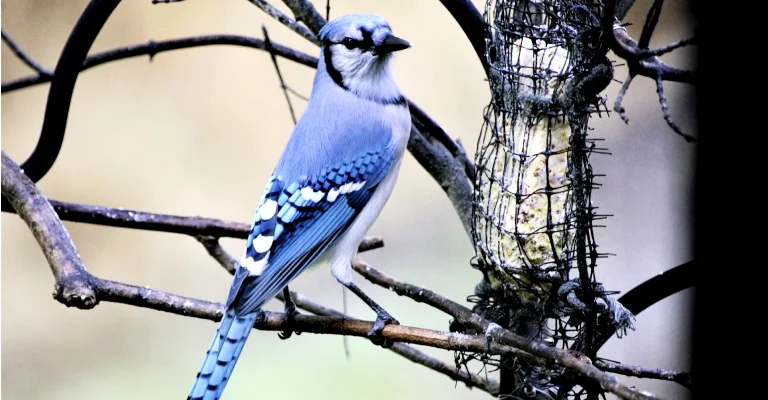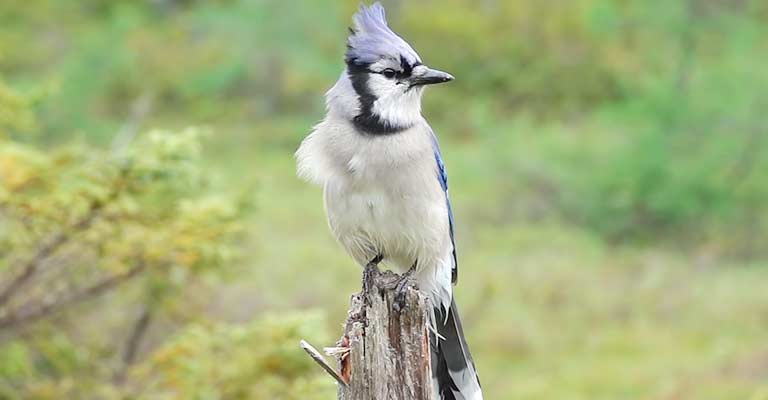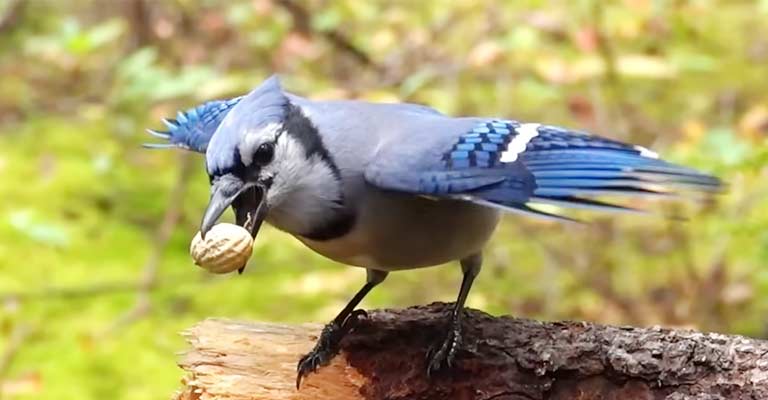Blue jays, with their vibrant plumage and distinctive calls, can add a touch of nature’s beauty to your surroundings. However, when their enthusiastic presence becomes a daily disturbance, finding ways to peacefully coexist becomes essential.
These intelligent and social birds are known for their raucous calls and bold demeanor, often asserting their dominance in the avian hierarchy. While their behavior is fascinating, it can be a challenge when it disrupts the peace you crave in your backyard or garden.
In this comprehensive guide, we’ll delve into the nuances of blue jay behavior, helping you understand how to get rid of annoying blue jays.
Armed with this knowledge, we’ll explore a range of humane strategies to gently discourage these boisterous birds from overstaying their welcome.
From adjusting your bird feeder setup to incorporating visual and auditory deterrents, we’ll provide practical solutions that respect both nature and your need for tranquility.

How to Get Rid of Annoying Blue Jays?
Before delving into solutions, it’s crucial to understand why blue jays might be causing a disturbance. Blue jays are known for their social nature, intelligence, and assertive behavior.
They are often attracted to bird feeders, seeking out seeds and nuts. Their territorial instincts can lead to aggressive interactions with other birds, potentially monopolizing feeders and creating a noisy environment.
Modify Your Bird Feeder Setup
One effective strategy is to modify your bird feeder setup to make it less inviting to blue jays. Opt for feeders with smaller perches or trays that are challenging for larger birds like blue jays to comfortably access.
Additionally, consider using specialized feeders designed to dispense smaller seeds, as blue jays prefer larger ones.
Strategic Seed Selection
Adjusting the type of seeds, you offer can also influence blue jay behavior. Blue jays are particularly fond of peanuts and sunflower seeds.
By opting for seeds less appealing to them, such as safflower seeds, you can reduce their interest in your feeder without discouraging other songbirds.
Implement Visual Deterrents
Blue jays are wary of their surroundings, and the presence of perceived threats can discourage them. Hanging shiny objects like CDs, reflective tape, or metallic wind chimes near the feeding area can create an environment that is less attractive to blue jays.
The movement and reflections can make them uneasy, encouraging them to seek alternative locations.
Auditory Deterrents
Consider incorporating auditory deterrents to disrupt the tranquility of blue jays without causing harm. Wind-activated devices that emit random, non-repeating sounds can startle and discourage blue jays from frequenting your space. Ensure that the sounds are not distressing to other wildlife or your neighbors.
Create Physical Barriers

To limit the access of blue jays to your bird feeders, you can create physical barriers. Use wire cages or mesh around your feeders, allowing smaller birds to access them while preventing larger birds like blue jays from dominating the feeding area.
Timing Your Feeding Schedule
Establishing a consistent feeding schedule can also influence blue jay behavior. Birds are creatures of habit, and adjusting the times when you provide food can disrupt their routine. Consider feeding birds earlier in the morning or later in the evening when blue jays might be less active.
Provide Alternative Food Sources
Encourage blue jays to forage elsewhere by providing alternative food sources away from your primary feeding area.
Scatter seeds on the ground or set up a separate feeding station designed specifically for larger birds. This can help redirect their attention, reducing their impact on your preferred bird feeding spot.
Natural Landscaping
Consider the landscaping around your home, as it can influence the behavior of blue jays. Planting dense shrubs and trees provides smaller birds with refuge and makes it more challenging for blue jays to navigate and dominate feeding areas. A well-planned garden can create a harmonious environment.
Be Patient and Consistent
Changing the behavior of blue jays requires patience and consistency. Implementing these strategies may not yield immediate results, but over time, blue jays may adapt to the altered conditions and seek alternative locations for feeding. Be persistent in your efforts, adjusting your approach as needed.
What Brings Blue Jays to Your Yard?

Blue jays, with their striking blue plumage and distinctive calls, are a captivating presence in any backyard. However, their enthusiastic visits can sometimes become a source of curiosity and, for some, occasional frustration.
To better appreciate these birds and manage their presence, let’s explore the factors that draw blue jays to your yard and how you can coexist harmoniously with these intelligent and lively creatures.
Abundant Food Sources
Blue jays are opportunistic feeders with a diverse diet, including nuts, seeds, insects, fruits, and even small vertebrates.
If your yard provides a variety of these food sources, especially in bird feeders, it becomes a prime destination for blue jays. Sunflower seeds, peanuts, and suet are particularly attractive to them.
Solution
Consider diversifying the types of bird feed you offer. While sunflower seeds are a favorite, incorporating safflower seeds or millet may attract a broader range of birds while potentially reducing the dominance of blue jays.
Bird Feeders
Bird feeders, while intended to attract a variety of bird species, can sometimes draw an overwhelming number of blue jays due to their assertive nature. Blue jays are not only attracted to the seeds but also to the competitive environment around feeders.
Solution
Modify your bird feeder setup to make it less appealing to blue jays. Choose feeders with smaller perches or trays, making it challenging for larger birds like blue jays to comfortably access the seeds. This can create a more balanced feeding environment.
Nesting Sites
Blue jays are territorial birds and are protective of their nesting sites. If your yard provides suitable trees or shrubs for nesting, it may attract blue jays, especially during the breeding season. They may become more vocal and assertive in defending their territory.
Solution
While it’s important to respect nesting birds, ensuring a variety of nesting options may disperse blue jays and prevent territorial disputes. Dense shrubbery and diverse tree species can accommodate a range of nesting preferences.
Water Sources
Blue jays, like many birds, are attracted to water for drinking and bathing. If your yard features birdbaths or other water sources, it can make your space even more enticing to these feathered visitors.
Solution
Maintain clean and accessible water sources. Consider adding features like drippers or misters, which can provide not only drinking water but also create an inviting atmosphere for a variety of birds.
Presence of Other Birds
Blue jays are social birds but can also be competitive around food and territory. If your yard attracts smaller birds, it’s likely to draw blue jays looking to assert their dominance.
Solution
Create a balanced environment by providing feeding areas suitable for both small and large birds. This can be achieved through a combination of feeder types, food choices, and spatial arrangement to accommodate different bird species.
Environmental Factors
Blue jays are adaptable and can thrive in various environments. If your yard offers a mix of open spaces and sheltered areas, it becomes an attractive location for these birds seeking diverse habitats.
Solution
Maintain a well-balanced landscape with open spaces, trees, and shrubs. This provides an appealing environment for a variety of birds while preventing the complete domination of blue jays.
Seasonal Variations
Blue jays’ behavior can vary seasonally. During the breeding season, they may become more territorial and vocal. Understanding these fluctuations can help you anticipate and manage their presence accordingly.
Solution
Be mindful of seasonal changes and adjust your approach accordingly. If blue jays become more assertive during breeding season, consider temporarily modifying your bird feeder setup or increasing the variety of food sources.
Understanding the factors that attract them allows you to make informed decisions to manage their presence without compromising the beauty of their visits.
By implementing thoughtful strategies such as diversifying food options, modifying bird feeder setups, and creating a well-balanced landscape, you can foster a harmonious coexistence with these vibrant and intelligent birds.
FAQs
Why are Blue Jays Considered Annoying?
Blue jays can be considered annoying due to their bold and assertive behavior. They often dominate bird feeders, monopolizing resources and creating a noisy environment. Their territorial nature can lead to conflicts with other birds, making their presence disruptive in certain settings.
What Attracts Blue Jays to Bird Feeders?
Blue jays are attracted to bird feeders primarily because of the abundance of food, especially sunflower seeds, peanuts, and suet. Their competitive nature leads them to seek out these resources, making bird feeders a popular destination for these intelligent and opportunistic birds.
Are Blue Jays Harmful to Other Birds?
While blue jays can be competitive around bird feeders, they are not inherently harmful to other birds. However, their dominance may discourage smaller birds from accessing food. Implementing strategies like modifying feeder setups can help create a more inclusive environment.
How Can I Discourage Blue Jays Without Harming Them?
Discouraging blue jays can be done without causing harm by implementing humane strategies. This includes modifying bird feeder setups with smaller perches, using visual and auditory deterrents, and providing alternative food sources away from primary feeding areas.
What Role Do Blue Jays Play in the Ecosystem?
Blue jays play a vital role in the ecosystem as seed dispersers. They collect and cache seeds, helping with the natural regeneration of forests. Their presence also contributes to pest control by feeding on insects.
While their assertive behavior at feeders can be challenging, appreciating their ecological role can foster a more positive perspective.
Conclusion
Fostering a harmonious coexistence with blue jays involves a blend of understanding, respect, and strategic intervention.
By deciphering the intricacies of blue jay behavior, we gain insight into their needs and motivations, enabling us to address the root causes of their presence.
The journey towards a more serene environment is marked by thoughtful adjustments – from modifying bird feeder configurations to implementing subtle deterrents.
As we navigate this balance, it’s crucial to appreciate the essence of these vibrant creatures without sacrificing the peace of your space.
Through humane and considerate measures, we can transform annoyance into a symphony of coexistence, where the beauty of nature and the tranquility of your surroundings complement each other.
Remember, the goal is not to exclude, but to find a middle ground where both you and the blue jays can thrive in a shared landscape of peace and natural splendor.